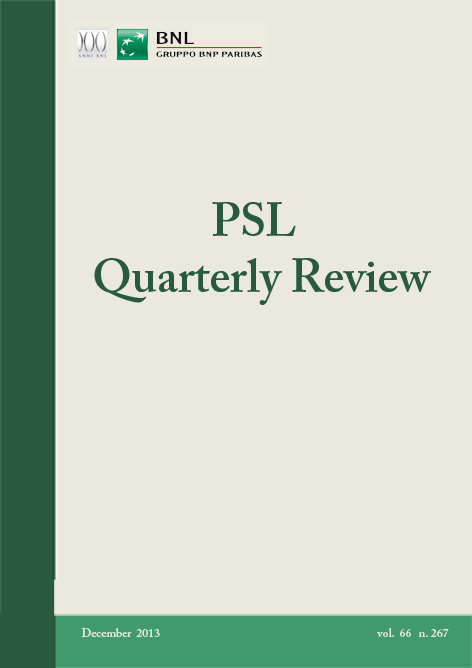Income distribution in a monetary economy
DOI:
https://doi.org/10.13133/2037-3643/11365Keywords:
Economics, Macroeconomics, Post-Keynesian EconomicsAbstract
In a monetary economy capital is a fund. This idea is captured by the circuit of capital. We define a circuit for fixed capital and argue that it is closed when the fund that initiates it is recovered in a present value sense. The circuit of newly invested fixed capital must be equivalent to the comparable direct circuit of money. This is the condition for monetary equilibrium in the sense of Keynes. From this equivalence it is possible to determine what the imputation for fixed capital must be, implying a definitive income distribution. The solution implies that capital assets that last longerthan the period of the circuit earn pure rent.
JEL codes: D33, D46, E11, E12, E25
References
AOKI M. (2001), “To the Rescue or to the Abyss: Notes on the Marx in Keynes”, Journal of Economic Issues, vol. 35 n. 4, pp. 931-954.
ASIMAKOPULOS A. (1975), “A Kaleckian Theory of Income Distribution”, The Canadian Journal of Economics, vol. 8 n. 3, pp. 313-333.
BERTOCCO G. (2005), “The Role of Credit in a Keynesian Monetary Economy”, Review of Political Economy, vol. 17 n. 4, pp. 489-511.
BRENNER R. (1980), “The Role of Nominal Wage Contracts in Keynes’ General Theory”, History of Political Economy, vol. 12 n. 4, pp. 582-587.
DAVIDSON P. (1980), “The Dual-Faceted Nature of the Keynesian Revolution: Money and Money Wages in Unemployment and Production Flow Prices”, Journal of Post Keynesian Economics, vol. 2 n. 3, pp. 291-307.
DILLARD D. (1984), “Keynes and Marx: A Centennial Appraisal”, Journal of Post Keynesian Economics, vol. 6 n. 3, pp. 421-432.
DILLARD D. (1987), “Money as an Institution of Capitalism”, Journal of Economic Issues, vol. 21 n. 4), pp. 1623-1647.
FOLEY D. (1986), Understanding Capital, Cambridge (Mass.): Harvard University Press.
GODDEN D. (2001), “Investment Appraisal in UK Manufacturing: Has it Changed since the Mid-1990s?”, Confederation of British Industry Discussion Paper, available at http://www.cbi.org.uk/.
GRAZIANI A. (2003), The Monetary Theory of Production, Cambridge: Cambridge University Press.
HICKS J. (1974), “Capital Controversies: Ancient and Modern”, The American Economic Review, vol. 64 n. 2, pp. 307-316.
KALDOR N. (1956), “Alternative Theories of Distribution”, The Review of Economic Studies, vol. 23 n. 2, pp. 83-100.
KEYNES J.M. (1973), The General Theory of Employment, Interest and Money, London and Basingstoke: Macmillan.
LAVOIE M. (1995), “Interest Rates in Post-Keynesian Models of Growth and Distribution”, Metroeconomica, vol. 46 n. 2, pp. 146-177.
LERNER A.P. (1952), “The Essential Properties of Interest and Money”, The Quarterly Journal of Economics, vol. 66 n. 2, pp. 172-193.
PANICO C. (1980), “Marx’s Analysis of the Relationship between the Rate of Interest and the Rate of Profits”, Cambridge Journal of Economics, vol. 4 n. 4, pp. 363-378.
PANICO C. (1985), “Market Forces and the Relation between the Rates of Interest and Profits”, Contributions to Political Economy, vol. 4 n. 1, pp. 37-60.
PANICO C. (1997), “Government Deficits in Post-Keynesian Theories of Growth and Distribution”, Contributions to Political Economy, vol. 16 n. 1, pp. 61-86.
PASINETTI L.L. (1960), “A Mathematical Formulation of the Ricardian System”, The Review of Economic Studies, vol. 27 n. 2, pp. 78-98.
PIVETTI M. (1985), “On the Monetary Explanation of Distribution”, Political Economy, vol. 1 n. 2, pp. 73-103.
ROBINSON J. (1962), “The Basic Theory of Normal Prices”, The Quarterly Journal of Economics, vol. 76 n. 1, pp. 1-19.
SRAFFA P. (1960), Production of Commodities by Means of Commodities, Cambridge: Cambridge University Press.
Downloads
How to Cite
Issue
Section
License



